Exploring the Legend of Finn McCool: Irish Myth and the Giant’s Might
Was Finn McCool merely an epic yarn spun by ancient bards, or was he a tangible piece of Ireland’s storied history? This article cuts through the mythology to explore the man, the legends, and the lasting lore surrounding the Giant’s Causeway. Join us as we unravel the stories of Finn McCool, piecing together his place in Irish folklore and questioning his existence against the backdrop of history.
Key Takeaways
- Finn McCool, or Fionn mac Cumhaill, is an iconic figure in Irish mythology. He embodies the heroic spirit of Ireland, and stories emphasise his strength, intellect, and leadership of the warrior band called the Fianna.
- Under Finn McCool’s leadership, the Fianna were revered for their martial prowess and strict code of conduct. They demanded exceptional knowledge of poetry and history, physical agility, and a sole loyalty oath upon initiation.
- The legend of Finn MacCool includes the famous tale of the Giant’s Causeway, where his wit defeats the Scottish giant Benandonner, and the Salmon of Knowledge, which grants him profound wisdom, enhancing his mythic stature and influence on Ireland’s culture.
Table of Contents
The Enigma of Finn MacCool
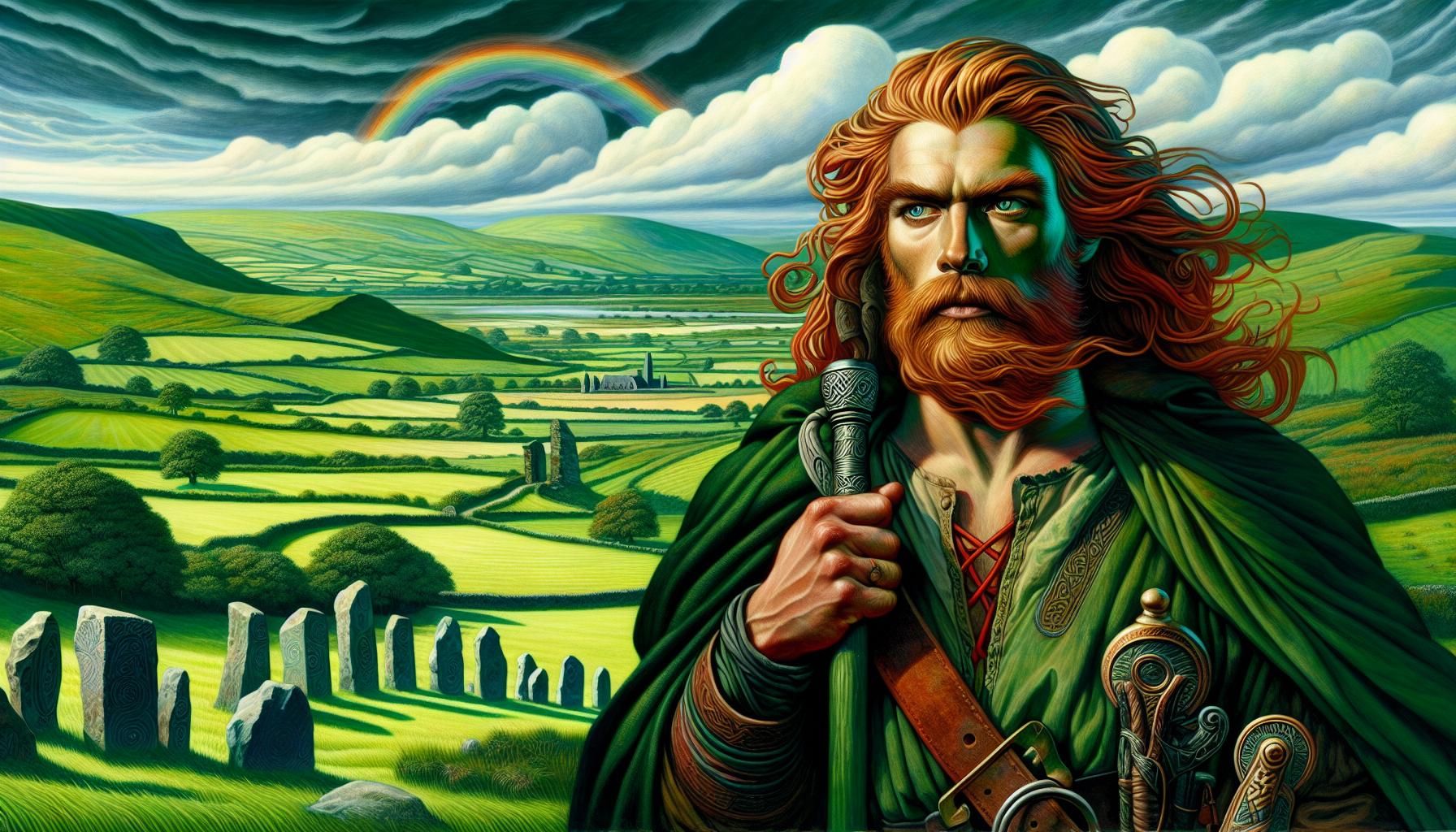
Within the rich tapestry of Irish mythology, few figures stand as tall, literally and figuratively, as Finn McCool, also known as Finn Mac Cool. Known for his legendary strength and intellect, Finn MacCool is a cornerstone of Irish folklore, and his name is synonymous with the heroic spirit of Ireland. From the rugged coastlines battered by the Irish Sea to the whispers of the Scottish island lore, the name of Finn McCool—or Fionn mac Cumhaill, Finn mac cumail, Finn mac cumhaill, and finn mac cumhal, as he is known in the native tongue—conjures images of a warrior of immense physical and mental prowess, a leader whose tales are integral to the ancient Finian Cycle.
The Origins of a Legend
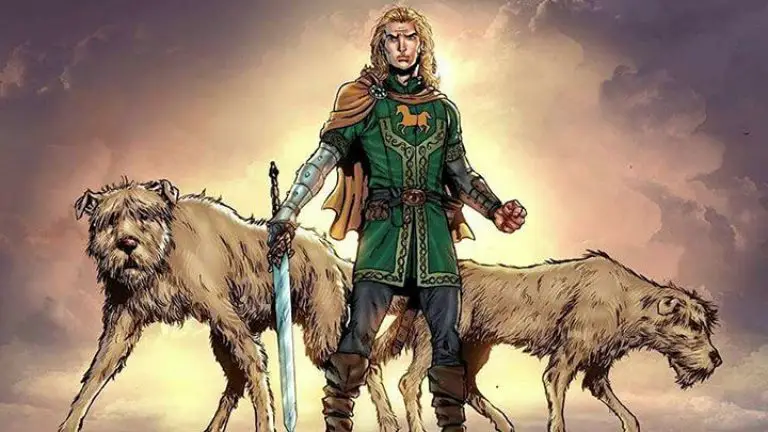
The legend of Finn Mac Cool is steeped in the cultural lineage of the Emerald Isle. His name, Fionn mac Cumhaill, is a beacon of ‘sureness’ and ‘certainty’, a symbol as sturdy as the young male deer it also represents. His roots stretch deep into the ancient soil of Ireland, tied to the tribe of U Thairsig, which grounds his legendary status in the fabric of Irish society and familial connections.
From this fertile ground of heritage, the legend of Finn Mac Cool sprouted, intertwining with the Irish myths and legends of other bardic romances that have shaped Irish folklore.
The Heroic Deeds of Young Finn
Fionn Mac Cumhaill journey to becoming a figure of myth began in his formative years. Under the tutelage of the wise druid Finnegas, young Finn acquired the teachings that would forge his path to greatness. His life was marked by boyish exploits and extraordinary events, such as the haunting transformation of his grandmother into a stone figure—an image immortalised on the windswept landscape of the Giant’s Causeway.
These early adventures laid the foundation for the young warrior’s legend, a prelude to the epic tales that would define him as the leader of the Fianna.
The Fianna: Finn McCool’s Band of Warriors
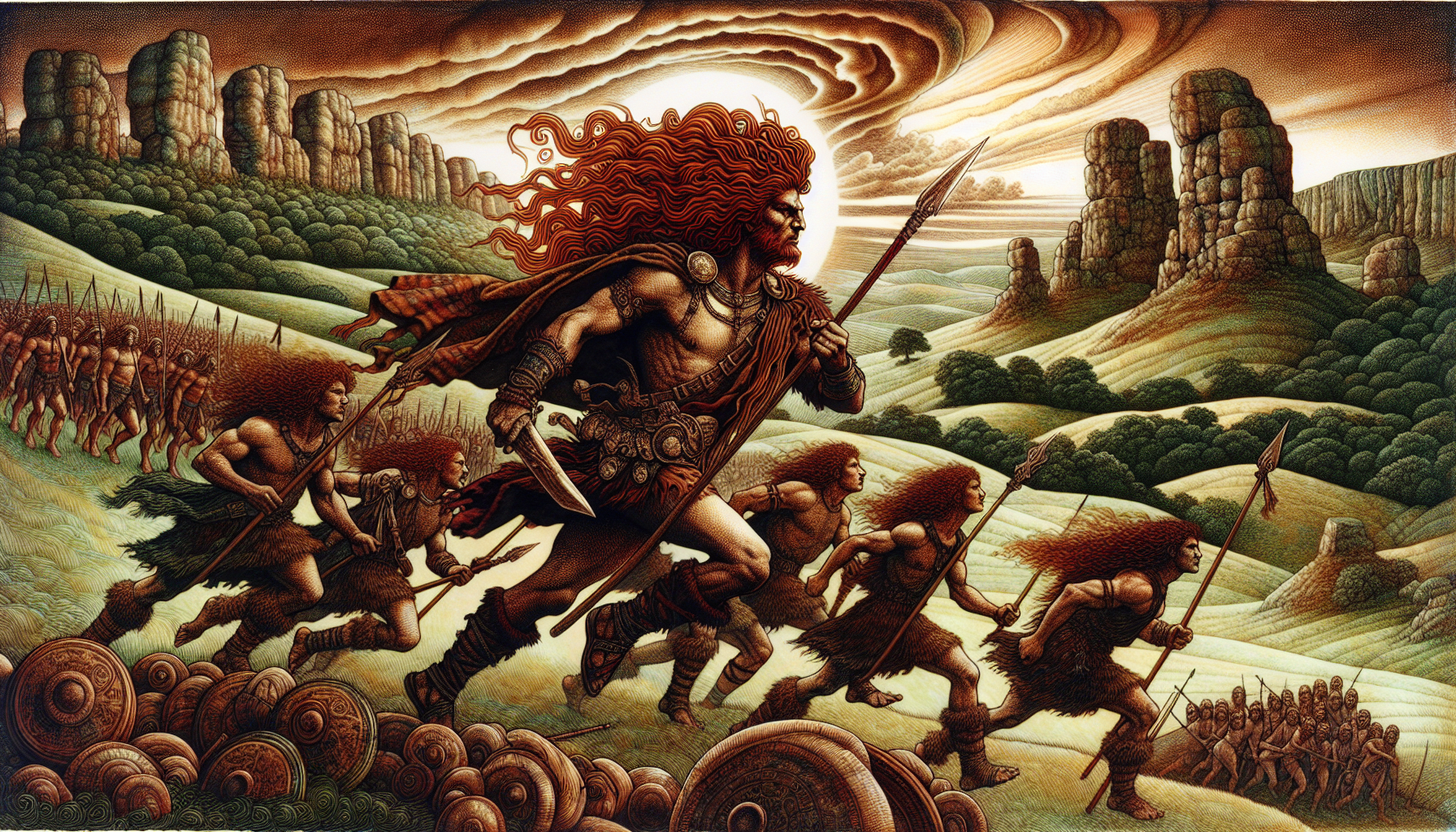
The Fianna, a band of elite warriors, embodied ancient Ireland’s martial valour, and Finn McCool stood at their helm. Renowned for their combat skills, they were also keepers of knowledge, mastering the arts of:
- poetry
- music
- genealogy
- history
Organised into cathas, or battalions, the Fianna were a force to be reckoned with, their numbers swelling from 9,000 during peacetime to an imposing 21,000 in times of conflict.
More than mere soldiers, they were the ‘soldiers of destiny’, their mythical importance and revered status woven into the very fabric of the Fenian Cycle.
The Criteria for Joining the Fianna
To join the ranks of the Fianna was to achieve an honour reserved for the few who could surpass the rigorous tests of intellect and might. Mastery of twelve books of poetry was the gatekeeper to this elite group, ensuring that each member was well-versed in the history and genealogies of Ireland.
Physical prowess was tested through a gauntlet of challenges, from evading spears to navigating forests without disturbing the natural si: this licence was a testament to the agility and quickness expected of a Fianna warrior. Combat skills were scrutinised, with candidates proving their steadiness of hand and bravery against multiple foes.
The final initiation was a symbolic severance of familial ties and a solemn oath to the Fianna, marking the transformation from aspirant to guardian of the High King.
The Code of the Fianna
The Fianna were bound by their combat skills and a code of honour that dictated their moral and societal conduct. Upon admission, each member took a solemn oath of loyalty, pledging to uphold the values that defined their order. This code was the cornerstone of Fianna’s reputation, influencing their decisions and ensuring their actions aligned with the highest standards of justice.
As their leader, Finn McCool was the paragon of these virtues—his every disembodied of the Fianna’s code, cementing his legacy in the annals of Irish mythology.
The Giant’s Causeway and the Battle of Wits
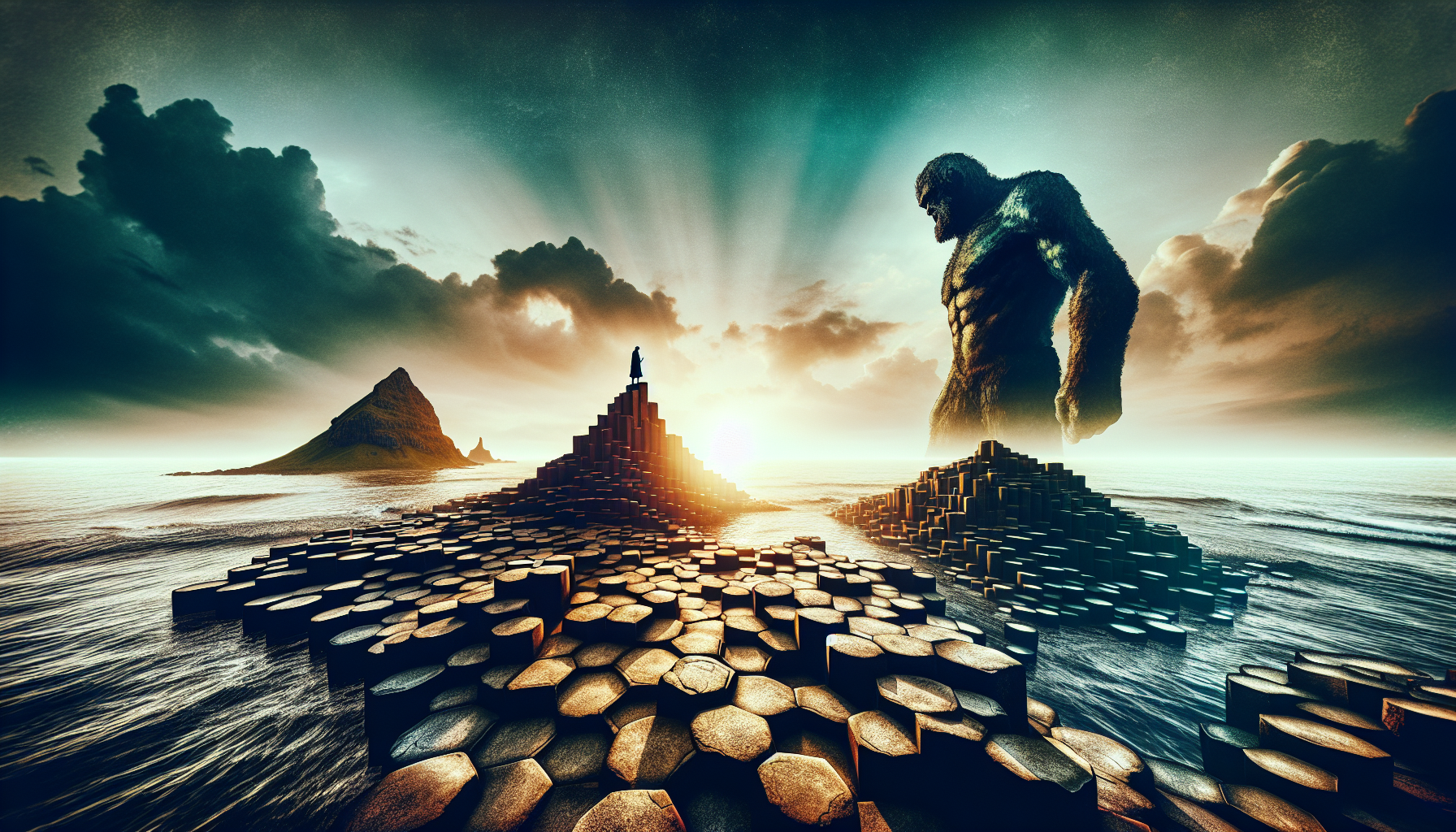
One of Finn McCool’s most renowned tales is the creation of the Giant’s Causeway, an enduring symbol of his cunning and might. This extraordinary formation was said to be a path engineered by Finn himself to confront the fearsome Scottish giant Benandonner across the tumultuous Irish Sea.
However, upon witnessing the staggering size of his adversary, Finn’s might gave way to wit as he hatched a plan to evade confrontation. With the help of his quick-thinking wife Oonagh, Finn disguised himself as a baby, tricking Benandonner into believing that a child of such size could only be sired by a giant far superior to himself, prompting the Scottish giant to flee in terror.
Geological Wonder Meets Myth
While the legend depicts a footpath built by a giant, science reveals a tale of its own. About 60 million years ago, the Giant’s Causeway was forged by the fiery wrath of volcanic activity, a time when Ireland was geologically connected to the North American continent. The striking hexagonal basalt columns that characterise the causeway resulted from cooling lava, which fractured as it flowed into a river valley, creating the natural wonder we see today.
Acknowledged as a UNESCO World Heritage Site, the Giant’s Causeway in Northern Ireland is a testament to the planet’s dynamic history and a canvas for the legends of Finn McCool.
The Salmon of Knowledge and Finn’s Wisdom
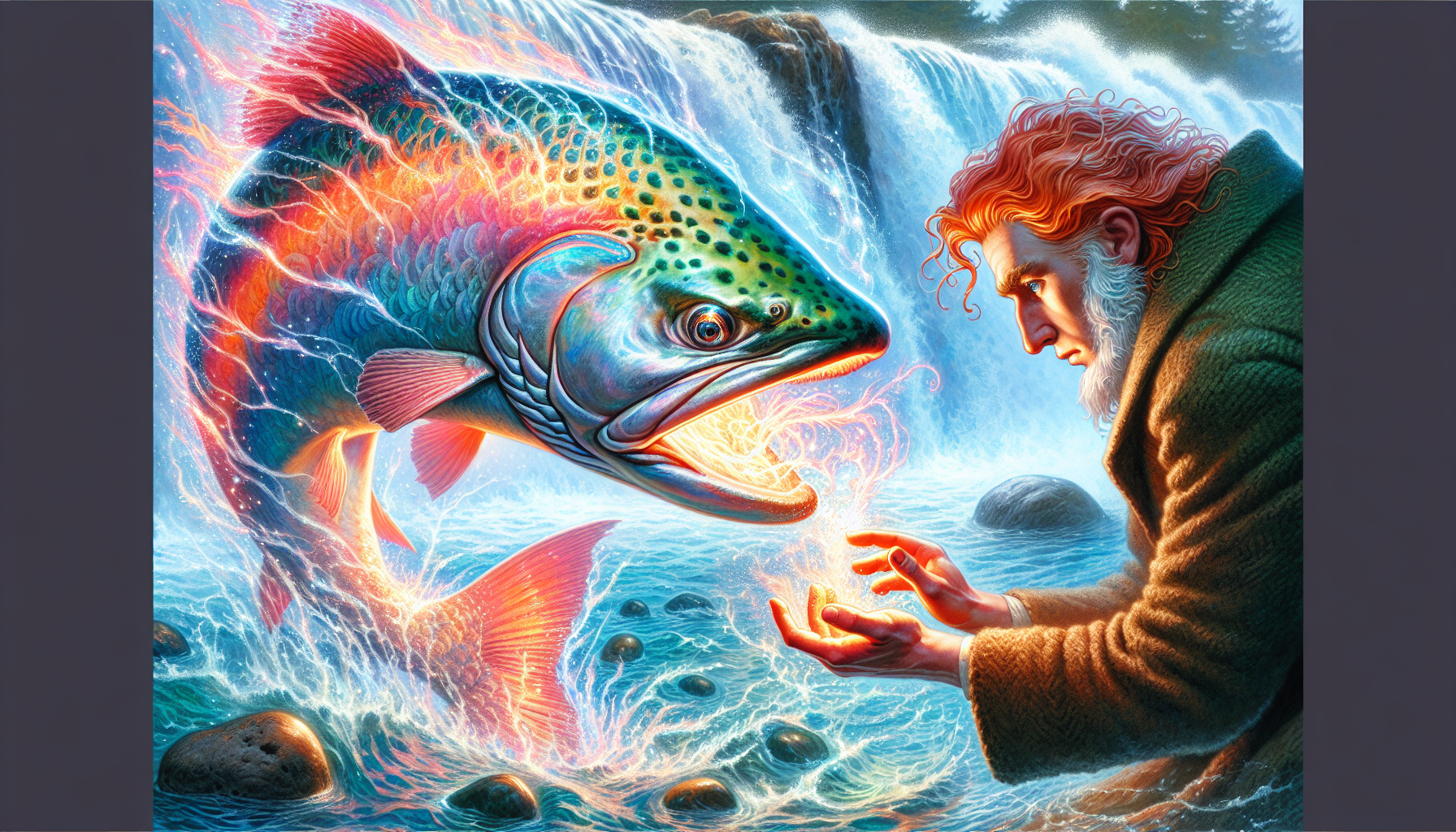
The Salmon of Knowledge is a cornerstone of Finn McCool’s mythos, a creature whose wisdom would become integral to Finn’s legend. According to the tales, the salmon gain profound knowledge from the hazelnuts of a sacred well, a source of wisdom shrouded in mystery and protected by nine hazeltrees.
Under Finnegas’ guidance, young Finn was tasked with cooking the salmon but inadvertently tasted its fat, thus absorbing the salmon’s wisdom. Recognising the transformation in Finn’s gaze, Finnegas granted the rest of the fish to his pupil, granting him the knowledge to lead the Fianna and protect the realm. This gift of wisdom, invoked by the bite of a thumb, became Finn’s beacon throughout his life, a source of insight in times of need.
The Love Stories of Finn McCool
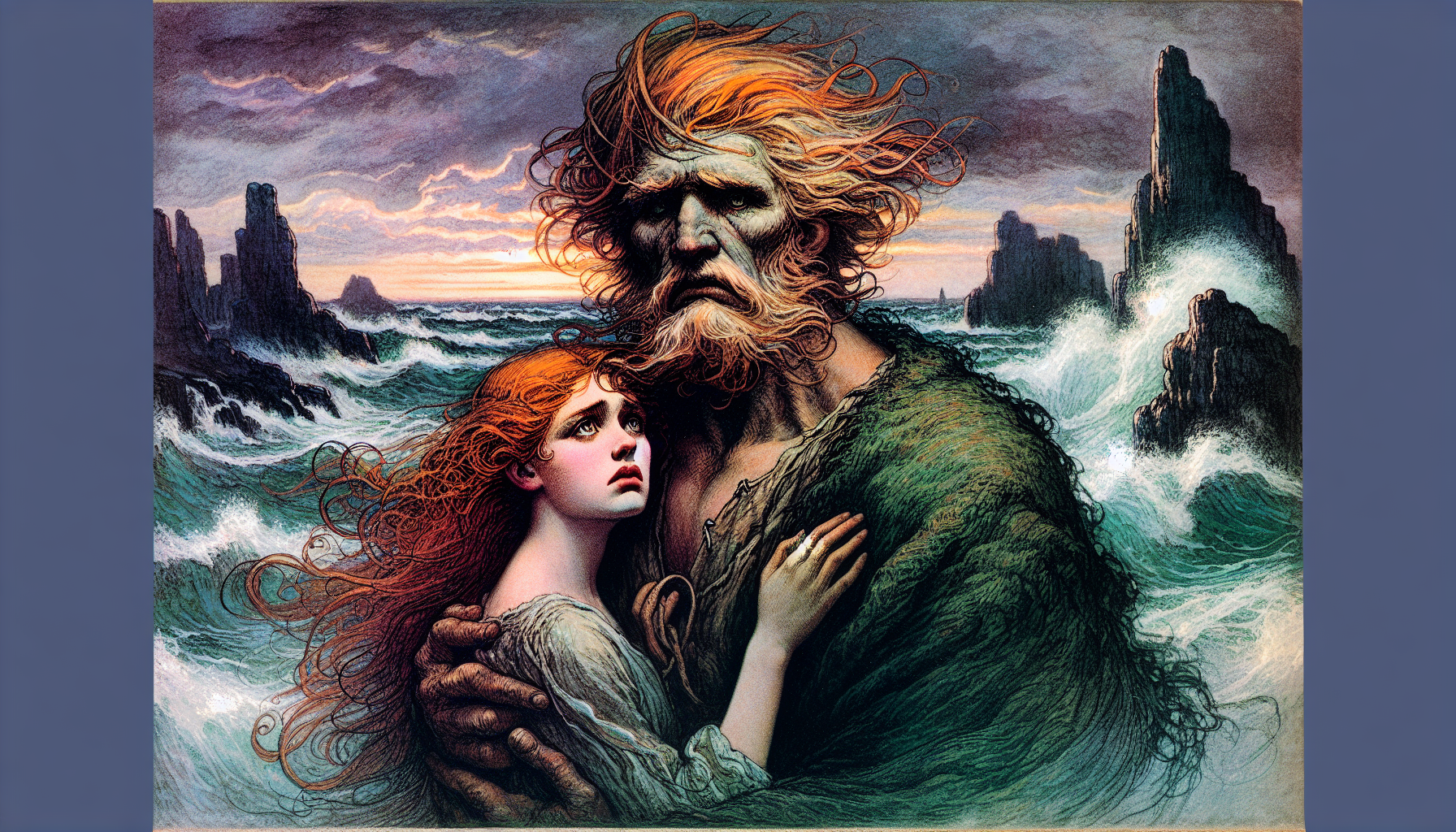
Finn McCool’s exploits were not confined to the battlefield; his heart was the stage for epic sagas. His pursuit of love led him to Gráinne, the High King’s daughter, whose beauty and spirit matched his stature. However, the engagement festivities took a dramatic turn when Gráinne’s eyes met those of Diarmuid, the young warrior she had once sought, prompting a scandalous elopement and igniting Finn’s vengeful pursuit. This tumultuous love triangle is immortalised in the landscapes and legends of Ireland, a testament to the depth and complexity of Finn’s character.
Yet, before Gráinne, there was Sadhbh, a woman whose love story with Finn would be marked by magic and sorrow.
Tragic Transformations and Lost Loves
Finn’s encounter with Sadhbh is a poignant narrative of love and loss. Transformed into a deer by the spiteful druid Fear Doirich, Sadhbh regained her human form on Finn’s lands, sealing their bond. Yet, their happiness was fleeting as Fear Doirich’s magic ensnared Sadhbh once more, turning her back into a deer and forever severing their union.
Amidst this tragedy, their love bore fruit; Oisín, Finn’s son, emerged from this tale of enchantment, rescued from his fawn form by Finn’s hounds to join his father’s side. Local folklore, such as the figures etched into Keadeen Mountain, ensures that the story of Finn and Sadhbh remains woven into the cultural fabric of Ireland.
The Legacy of Finn McCool in Modern Culture
The legend of Finn McCool transcends the annals of ancient Ireland, finding a vibrant afterlife in the cultural expressions of today. Modern literature has amplified his mythic stature, often depicting him as a literal giant, a symbol of unrivalled wisdom and strength. His influence dances across stages worldwide, with performances like the Irish Riverdance narrating stories inspired by his legendary feats, demonstrating his enduring impact on dance culture.
From the panels of contemporary comics to the lyrics of musicals, Finn McCool’s adaptability to various forms of media is a testament to the timeless appeal of his legend, making him a true Finn Mac icon.
From Ancient Tales to Modern Retellings
The enduring allure of Finn McCool’s story is evident in its retellings across a spectrum of modern creative works. The Fianna Cycle, which chronicles his exploits, has inspired authors like James Stephens, whose 1920 rendition brought new life to the tales of the Fiannaocht.
Artists such as Emilie Gill have also contributed to this legacy, illustrating modern adaptations like ‘The Tall Tale of the Giant’s Causeway’, allowing new generations to connect with the legend through the visual arts.
The Death and Immortality of a Hero
The end of Finn McCool’s earthly journey is shrouded in mystery and contradiction. Some believe he rests eternally, slumbering in a cave alongside the Fianna, awaiting the moment when Ireland’s need is most significant, and the call of the Dord Fiann will awaken him to defend his homeland once more. Yet another narrative recounts his mortal fate, one where he met his tragic end at the Battle of Gabhra, beheaded while lamenting the fall of his grandson and the uncertain destiny of the Fianna.
These varied accounts of his death, found in historical annals and folk legends, reflect the complexity of his character and the enduring nature of his myth.
Sheemore and Other Claimed Resting Places
While some tales speak of an eternal vigil, others point to final resting places, such as the hill of Sheemore in East Leitrim. Steeped in mythology, this hill is revered in local folklore as the last abode of the legendary Finn McCool and Goll Mac Morna. This site echoes the valour of Ireland’s greatest heroes.
The Real Versus the Mythical: Finn McCool’s Historical Roots
The figure of Finn McCool vacillates between myth and reality. Historical records suggest that he may have been a real warrior chieftain in 3rd-century AD medieval Ireland, a leader who inspired the stories that have flourished for centuries. Debates continue to swirl, much like the mists of the Irish countryside, about the veracity of his existence, drawing parallels with other legendary figures such as King Arthur and Robin Hood.
Archaeological investigations, like those at Sheebeg near Carrick on Shannon, have unearthed skeletons positioned towards the Hill of Tara, fueling speculation about their connection to the legendary Finn McCool.
Summary
In the whispers of the wind across the moors, in the tales told by the fireside, Finn McCool’s legend lives on, a timeless narrative etched into the bedrock of Irish culture. Through his original leadership, cunning, and heart, we have travelled across a panorama of mythology that captures the essence of a hero whose story is as boundless as the sea. Let the legend of Finn McCool inspire us to seek the extraordinary in our own lives, for in his tales, we find the courage and wisdom that define the human spirit.
Frequently Asked Questions
Is Finn McCool Scottish or Irish?
Finn McCool is Irish, as he is a mythological Irish giant who had a conflict with a Scottish giant. This links Finn McCool to Ireland.
Who was Finn McCool?
Finn McCool, also known as Fionn mac Cumhaill, is a legendary Irish hero celebrated for his wisdom and strength. He plays a central role in Irish mythology, particularly within the Fenian Cycle, and is known for his adventures, battles, and leadership of the warrior band known as the Fianna.
What is the significance of the Giant’s Causeway in Finn McCool’s legend?
The Giant’s Causeway is significant in Finn McCool’s legend as it is believed to be the path created by Finn McCool to confront his rival in Scotland, representing his strength and resourcefulness.
How did Finn McCool gain his wisdom?
Finn McCool gains wisdom from the Salmon of Knowledge, which he accidentally tasted while cooking for his mentor, the druid Finnegas. This bestowed upon him all the world’s knowledge, which he could access by biting his thumb.
Are there any modern adaptations of Finn McCool’s story?
Yes, Finn McCool’s story has been adapted into various modern media, including literature, visual arts, dance, music, and comics, such as James Stephens’ retelling of the Fiannaocht and Emilie Gill’s illustrations for ‘The Tall Tale of the Giant’s Causeway’.

